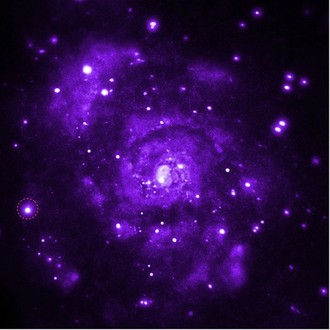
In a recent article, "Ultraluminous X-ray sources - new distance indicators?", accepted for Astronomy & Astrophysics Letters, group of Warsaw Astronomers lead by Agata Różańska from the Copernicus Astronomical Center have shawn that the broadband spectra of ULX sources, P13 in NGC7793, ULX1 in NGC5907, and ULX5 in Circinus galaxy, are well fitted by a single model component. The best fit model indicates that all ULXs have a hot neutron star in their centers, with the disk with high inner temperatures.
Obtained results clearly show that the integration over true intensity emitted by a given surface should be applied to explain emission from non-spherical systems. When this is done, we obtain a new possibility to explain broadband spectra via a single model component. Furthermore, we can derive the distance to the source from the model normalization. Authors derived the distance to P13, $D=3.41^{+0.11}_{-0.10}$~Mpc, which is in very good agreement with the Cepheids distance $3.4 \pm 17$~Mpc (Pietrzynski et al. 2010). In the case of ULX1, the distance resulting from their model is $D=6.55_{-0.81}^{+0.69}$~Mpc, a factor of two lower than previous estimates but both previous estimates reported two different numbers (13 and 17 Mpc) for the distance to this source. The distance to ULX5 obtained by discussed method $D=2.60^{+0.05}_{-0.03}$~Mpc is in agreement with the value of 2.78~Mpc found by Koribalski et al. (2004), using radial velocity measurements.
There is a more general result of this analysis. Any additional soft X-ray bump, which is very often observed in X-ray spectra of accreting objects, is usually fitted by separate model components, either disk or blackbody. Warsaw astronomers have proven that this problem can be solved when one integrate emission over the disk with a hot inner
source. Such central hot source may be for instance a neutron star or a hot corona, and may be partially attenuated by the disk.
Picture: Chandra image of the Whirlpool Galaxy in X-rays, with ULX 8 at the center of the dotted circle. Credit: X-ray: NASA/CXC/Caltech/M. Brightman et al.






